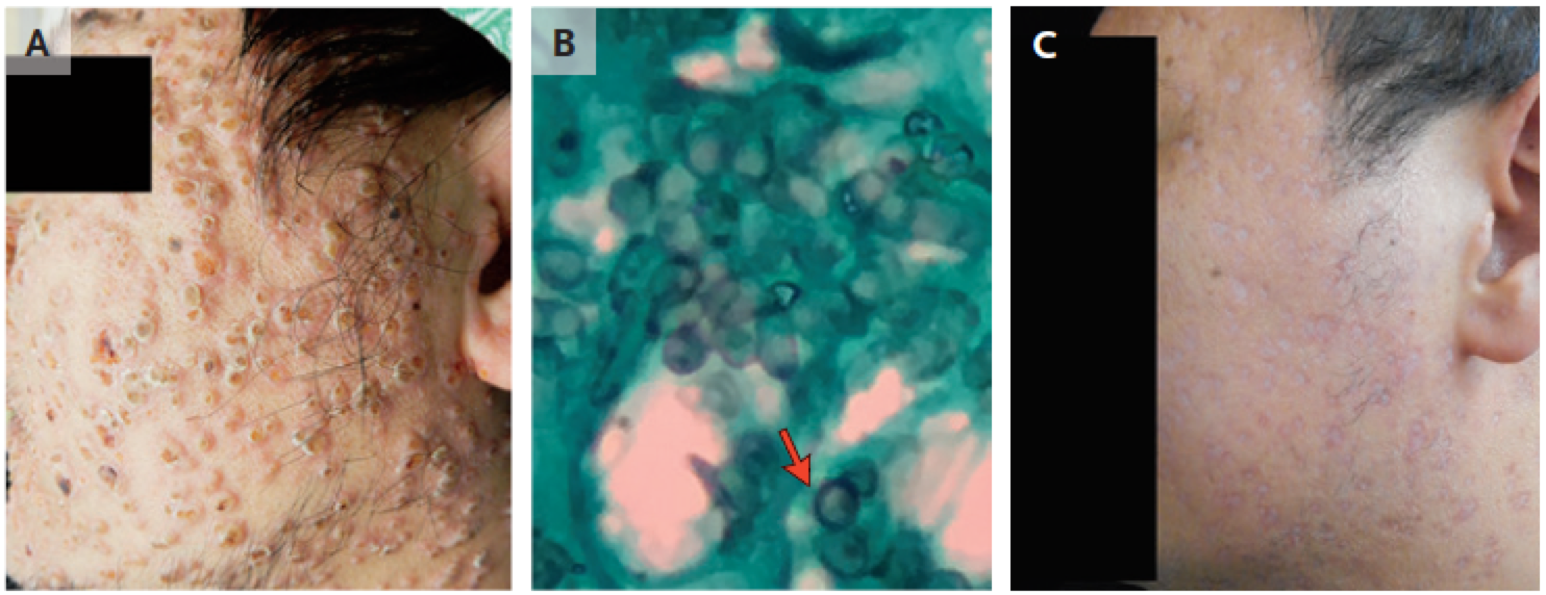Images in Clinical Medicine
Talaromyces marneffei Infection
Zixiang Si, Jianjun Qiao
N Engl J Med 2017; 377: 2580
DOI:10.1056/NEJMicm1704164
A 29-year-old man presented to an outpatient clinic with a 2-month history of fever, cough, dyspnea, and weight loss, as well as skin lesions that had developed on his face, neck, trunk, arms, and legs over a period of 2 weeks. Physical examination revealed extensive umbilicated papules (Panel A). A biopsy specimen obtained from a papule showed numerous round fungal structures in histiocytes (Panel B, methenamine silver stain; the arrow indicates a representative fungal structure). Tissue culture grew Talaromyces marneffei (formerly Penicillium marneffei) (Figs. S1 and S2 in the Supplementary Appendix, available at NEJM.org). Serologic testing was positive for the human immunodeficiency virus (HIV), with a CD4+ count of 25 cells per cubic millimeter. T. marneffei is a dimorphic fungus that is endemic in southern China, Southeast Asia, and northeastern India and causes infection in people with HIV infection who live in these regions. The incidence of T. marneffei infection has decreased with the increased use of highly active antiretroviral therapy. However, there is now an increasing incidence of T. marneffei infection among other persons with impaired cell-mediated immunity, such as those who have undergone organ transplantation. In this patient, treatment with intravenous amphotericin B was initiated, and 2 weeks later, antiretroviral therapy was started. Four months later, the cutaneous papules had diminished substantially, with residual superficial atrophic scars (Panel C).
一名29岁男性患者因发热、咳嗽、呼吸困难、体重下降2个月,以及面、颈、躯干和四肢皮损2周到门诊就诊。体格检查发现弥漫性脐状丘疹(图A)。丘疹活检标本发现组织细胞中很多圆形真菌结构(图B,六铵银染色;箭头提示典型的真菌结构)。组织培养分离到马尼菲篮状菌(以前称马尼菲青霉菌)。HIV血清学检测阳性,CD4细胞25/mm3。马尼菲篮状菌是一种二相性真菌,在中国南部、东南亚及印度东北流行,可引起HIV患者感染。随着高效抗逆转录病毒治疗的广泛使用,马尼菲篮状菌感染发生率逐渐降低。然而,其他细胞免疫障碍的患者(如接受器官移植的患者)马尼菲篮状菌感染不断增加。此例患者使用静脉两性霉素B,2周后开始抗逆转录病毒治疗。4个月后,皮肤丘疹显著减少,仅残留浅表萎缩性瘢痕(图C)。
